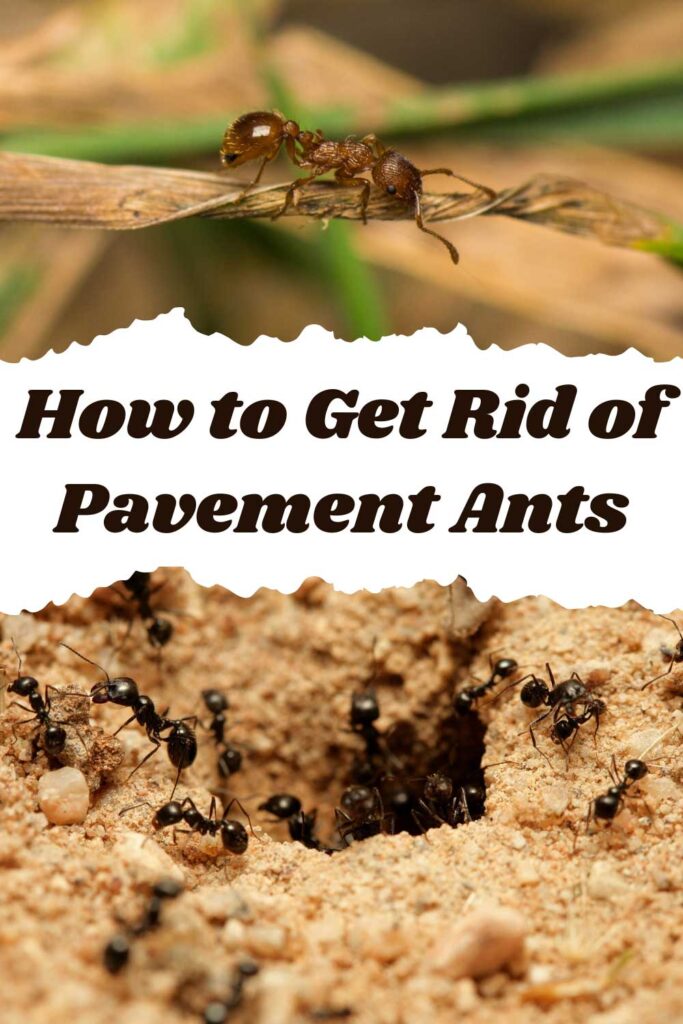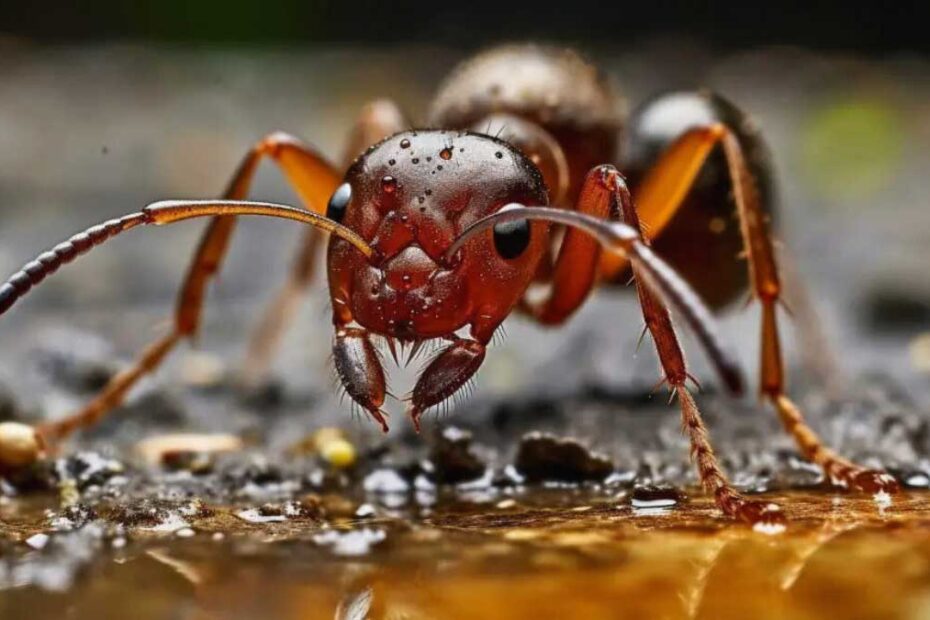Pavement ants can be a real nuisance, invading your home and garden in search of food. These tiny intruders often form colonies in cracks and crevices, making them tough to eliminate. If you’ve noticed a trail of these persistent pests, it’s time to take action before they become a bigger problem.
Understanding how to get rid of pavement ants effectively requires a strategic approach. You’ll need to identify their entry points, eliminate their food sources, and use targeted treatments to eradicate the colony. By following a few simple steps, you can reclaim your space and keep these unwelcome guests at bay.
Key Takeaways
- Identification and Behavior: Pavement ants are small, dark brown to black ants that typically nest in cracks, under stones, and in building foundations. Recognizing their appearance and nocturnal foraging behavior is crucial for effective management.
- Signs of Infestation: Common signs include visible ant trails, piles of debris near potential nest sites, and swarms of winged ants. Identifying these early indicators can help you address the problem promptly.
- Preventive Measures: Seal entry points with caulking, install door sweeps, and maintain proper sanitation by storing food in airtight containers and cleaning up spills immediately. Regularly take out the trash to reduce food sources for ants.
- Effective Treatments: Both natural remedies (such as vinegar solutions and boric acid) and chemical treatments (like ant baits and insecticide sprays) can be used to eradicate pavement ants. In severe cases, professional extermination may be necessary for thorough elimination.
- Long-term Maintenance: Consistent monitoring and preventive strategies, including sealing potential entry points and maintaining cleanliness, are essential for preventing future infestations and keeping pavement ants at bay.

Understanding Pavement Ants
Pavement ants, known for nesting in sidewalks and building foundations, invade homes in search of food. Understanding their characteristics can help in effectively eliminating them.
Identification
Identifying pavement ants involves recognizing their distinct appearance and behavior patterns.
- Appearance:
- Color: Usually dark brown to black.
- Size: Workers are about 1/8 inch long.
- Body Structure: Features parallel lines visible on the head and thorax.
- Colony Size: Can range from a few hundred to several thousand ants.
Behavior and Habitat
Understanding the behavior and habitat of pavement ants is crucial for targeted treatment.
- Nesting Sites:
- Outdoors: Pavement cracks, under stones, and logs.
- Indoors: Under floors, inside walls, near heat sources.
- Behavior Patterns:
- Foraging: Primarily nocturnal, they enter homes for food, including sweets, grease, and proteins.
- Colony Movement: Known to swarm and form satellite colonies.
Common Signs of Infestation
Identifying the signs of a pavement ant infestation helps you tackle the problem early. Pavement ants leave distinct indicators that you can look out for. Here are the key signs:
Visible Ants
You might notice small, dark brown to black ants, about 1/8 inch long, moving in and around your home.
These ants often form trails as they forage for food, especially at night.
Piles of Debris
Pavement ants create piles of sand, soil, or debris as they excavate their nests.
Look for these piles near cracks in pavement, along baseboards, or behind appliances.
Ant Trails
Traces of ants may be seen along edges of countertops, window sills, and around food sources.
Ant trails often lead back to nest sites, such as cracks in the floor or outside under stones.
Swarms
You may observe swarms of winged ants, particularly in spring or early summer.
These swarms indicate that the colony is mature and expanding.
Nest Sites
Pavement ants typically nest in the soil beneath pavement cracks, rocks, and building foundations.
Indoors, they prefer sheltered, warm areas like under floors and near heat sources.
Foraging Activity
Pavement ants forage for sweet, greasy, and protein-rich foods.
Frequent sightings in your kitchen or pantry can signal an infestation.
Recognizing these signs of infestation helps you take swift action to eliminate pavement ants from your property.
Preventive Measures
Implementing preventive measures is crucial in keeping pavement ants out of your home. By addressing potential entry points and maintaining proper sanitation, you can significantly reduce the likelihood of an infestation.
Sealing Entry Points
Pavement ants typically enter homes through small cracks and crevices. To keep these pests at bay, you’ll need to seal all potential entry points.
- Inspect for Gaps: Check around windows, doors, and the foundation of your home for gaps or cracks.
- Use Caulking: Apply caulk to seal any openings found during your inspection.
- Install Door Sweeps: Add door sweeps to exterior doors to prevent ants from entering under the door.
- Seal Utility Openings: Ensure that gaps around pipes, cables, and other utilities are properly sealed with an appropriate material.
Proper Sanitation
Maintaining a clean environment discourages pavement ants from foraging inside your home. Focus on removing food sources that might attract ants.
- Store Food Properly: Keep food in airtight containers, especially items like sugar, flour, and snacks.
- Clean Up Spills: Wipe up any spills and crumbs immediately, paying special attention to kitchen counters and dining areas.
- Take Out the Trash: Dispose of garbage regularly and use trash cans with tight-fitting lids.
- Regular Cleaning: Sweep and mop floors frequently to eliminate potential food sources.
By following these preventive measures, you can create an environment that is less inviting to pavement ants, thereby reducing the risk of an infestation.
Effective Treatment Methods
Addressing a pavement ant infestation involves understanding various treatment methods. Each method varies from natural to chemical solutions, and in severe cases, professional extermination may be necessary.
Natural Remedies
Implementing natural remedies can provide an eco-friendly way to control pavement ants.
- Vinegar Solution: Mix equal parts of vinegar and water. Spray the solution on ant trails and entry points.
- Boric Acid and Sugar: Combine boric acid with sugar to attract ants. Place the mixture near entry points to poison the ants.
- Diatomaceous Earth: Spread food-grade diatomaceous earth in areas where ants are active. This substance dehydrates and kills ants.
- Essential Oils: Use oils like peppermint or tea tree. Dilute and spray these oils to repel ants.
Each method minimizes harm to pets and the environment while targeting ant colonies effectively.
Chemical Treatments
Chemical treatments offer a stronger approach to managing pavement ants.
- Ant Baits: Place ant baits containing slow-acting pesticides near trails. These baits are carried back to the nest, targeting the entire colony.
- Insecticide Sprays: Apply non-repellent insecticides around the home’s perimeter. These sprays are undetectable to ants and lead to colony eradication.
- Granular Insecticides: Use granular treatments for outdoor ant mounds. Spread around the nest to allow ants to carry the poison back to the colony.
- Barrier Treatments: Create a chemical barrier around your home’s foundation. This method prevents ants from entering indoor spaces.
When choosing chemical treatments, follow product instructions and consider potential environmental impacts.
Professional Extermination
In cases of severe infestations, professional extermination ensures thorough elimination.
- Inspection: A professional will inspect your property to identify the extent of the infestation and locate nests.
- Treatment Plan: Exterminators develop a tailored treatment plan that may include both bait and chemical applications.
- Follow-Up Services: Professionals often offer follow-up visits to ensure the treatment’s effectiveness and prevent future infestations.
- Safety Measures: Licensed exterminators use products safely, minimizing risks to humans and pets.
For persistent or large-scale infestations, professional extermination provides peace of mind with guaranteed results.
Long-term Maintenance
Establishing long-term maintenance strategies ensures pavement ants don’t return. This section outlines steps to monitor and prevent recurring infestations.
Monitoring
Regular monitoring detects early signs of pavement ants. Inspect commonly infested areas, such as:
- Kitchen and Pantry: Check for ant trails and food crumbs.
- Bathroom and Laundry Room: Look for moisture-damaged wood and standing water.
- Basement and Attic: Search for nests in dark, undisturbed corners.
Use these tips for effective monitoring:
- Weekly Inspections: Conduct thorough checks around entry points and possible nesting sites.
- Insect Traps: Place sticky traps in high-activity areas to capture ants and assess infestation levels.
- Night-Time Checks: Remember, pavement ants are nocturnal, so inspecting during evening hours can reveal hidden activity.
Ongoing Preventive Measures
Preventive measures help maintain an ant-free environment. Carry out these strategies to keep pavement ants at bay:
-
Seal Entry Points:
- Use caulk to fill gaps around windows, doors, and the foundation.
- Install door sweeps.
- Seal utility openings with mesh or sealant.
-
Proper Sanitation:
- Store food in airtight containers.
- Clean up spills immediately.
- Dispose of garbage regularly.
- Keep countertops and floors clean from crumbs and residues.
-
Outdoor Maintenance:
- Trim vegetation away from the house.
- Remove debris and woodpiles from the perimeter.
- Ensure proper drainage to avoid moisture accumulation near the foundation.
- Inspect for leaks and repair them promptly.
- Replace damaged wood and seal broken window sills.
Maintain vigilance through regular monitoring and preventive measures to keep your property free from pavement ants and ensure long-term peace of mind.
Conclusion
Dealing with pavement ants requires a strategic approach and ongoing vigilance. By understanding their behavior and taking proactive measures, you can effectively eliminate these pests from your home. Identify entry points, remove food sources, and apply targeted treatments to reclaim your space.
Remember to carry out preventive measures like sealing gaps and maintaining proper sanitation. For severe infestations, professional extermination may be necessary. Regular monitoring and maintenance will help keep your property free from pavement ants, ensuring long-term peace of mind.
Frequently Asked Questions
What are pavement ants?
Pavement ants are small, dark brown to black ants about 1/8 inch long, characterized by parallel lines on their head and thorax. They commonly invade homes and gardens in search of food.
How can I identify a pavement ant infestation?
Key signs of infestation include visible ant trails, piles of sand or debris from nest excavation, ant trails on countertops and window sills, swarms of winged ants in spring or early summer, and frequent foraging in kitchens or pantries.
What do pavement ants eat?
Pavement ants forage for sweets, grease, and proteins. They are known to be nocturnal, searching for food primarily during the night.
How do I prevent pavement ants from entering my home?
Seal potential entry points by inspecting and caulking gaps around windows, doors, and the foundation. Use door sweeps and seal utility openings. Maintain proper sanitation by storing food in airtight containers, promptly cleaning spills, and disposing of garbage regularly.
What are some natural remedies to get rid of pavement ants?
Natural remedies include using vinegar solutions, a mixture of boric acid and sugar, diatomaceous earth, and essential oils. These solutions are effective and minimize harm to pets and the environment.
What are some chemical treatments available for pavement ants?
Chemical treatments include ant baits, insecticide sprays, granular insecticides, and barrier treatments. These methods offer stronger approaches for managing infestations.
When should I consider professional extermination for pavement ants?
Professional extermination is recommended for persistent or large-scale infestations. Professionals provide thorough inspections, tailored treatment plans, and follow-up services to ensure effectiveness and prevent future problems.
What long-term maintenance strategies can keep pavement ants away?
Maintain regular monitoring with weekly inspections of common infested areas, such as kitchens, bathrooms, and basements. Use insect traps and conduct night-time checks for hidden activity. Seal entry points, maintain proper sanitation, trim vegetation, and manage moisture around the homeâs foundation.
